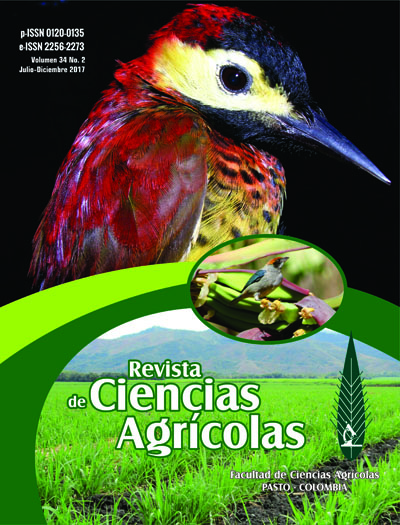Plant used by birds in coffee landscapes of Nariño, Colombia
Abstract
Plants are an important food resource for birds in coffee landscapes therefore the coffee plantations heterogeneity of guarantee its availability. Understanding the interactions between birds and plants is important for the biodiversity conservation in coffee landscapes. In this investigation, we present an initial list of plant species used by birds in coffee landscapes, in rural areas of the municipalities of Colón-Génova, La Unión, Arboleda and San Pedro de Cartago (Nariño, Colombia). The results showed that frugivorous birds fed from at least 25 species, nectarivorous birds from eight species and insectivorous birds foraged from nine species. The results obtained allow us to propose a list of potential plants (native and introduced), used as a food and foraging resource by birds, which could be useful for coffee landscapes management through the implementation of propagation and production strategies for coffee landscapes restoration.Downloads
References
APG III - The Angiosperm Phylogeny Group. 2009. An update of the Angiosperm Phylogeny Group classification for the orders and families of flowering plants: APG III. Botanical Journal of the Linnean Society. 161:105 - 121. doi: 10.1111/j.1095-8339.2009.00996.x.
Asociación Gaica - Federación Nacional de Cafeteros. 2012. Aves Del Paisaje Cafetero en el Departamento de Nariño Municipios Colón-Génova, La Unión, Arboleda y San Pedro De Cartago. Proyecto Incorporación de la Biodiversidad En El Sector Cafetero En Colombia. Asociación Gaica, San Juan de Pasto, Colombia. 146p.
Beer, J.; Ibrahim, M.; Somarriba, E.; Barrance, A.; Leakey R. 2004. Establecimiento y manejo de árboles en sistemas agroforestales. Capítulo 6. Árboles de Centroamérica. OFICATIE. 46p.
Borkhataria, R.; Collazo, J. A.; Groom, M. J.; Jordan-Garcia, A. 2012. Shade-Grown coffee in Puerto Rico: Opportunities to preserve biodiversity while reinvigorating a struggling agricultural commodity. Agriculture, Ecosystem and Enviroment. 149:164 - 170. doi: 10.1016/j.agee.2010.12.023.
Borrero, J. I. 1986. “La substitución de cafetales de sombrío por caturrales y su efecto negativo sobre la fauna”. Caldasia. 15:725 - 732. doi: 10.15446/caldasia.
Cole, T.; Hilger, H. 2010. Poster “Angiosperm phylogeny-APG III. En: http://www2.biologie.fu-berlin.de/sysbot/poster/poster1.pdf.1p; consulta: diciembre, 2012.
Giraldo, P.; Laina, A.; Lopez, J. H.; Aguirre, J.F.; Toro, Y. 2009. Café, una alternativa para la conservación. Wildlife Conservation Society, WWF Colombia, Asociación Red Colombiana de Reservas Naturales de la Sociedad Civil y Federación Nacional de Cafeteros. Primera edición, Santiago de Cali, Colombia. 76p.
Holdridge, L. R. 1967. Life Zone Ecology. Tropical Science Center. San José, Costa Rica. 206p.
Jiménez, F.; Muschler, R. 2001. Introducción a la agroforestería. Funciones y aplicaciones de sistemas agroforestales. Módulos de Enseñanza Agroforestal. CATIE/GTZ. 24p.
Missouri Botanical Garden’s Vast (Vascular Trópicos). 2012. Nomenclatural Database and Associated Authority Files. En: http://www.tropicos.org. 1 p; consulta: diciembre, 2012.
Muschler, R. G. 1999. Árboles en cafetales.. Proyecto Agroforestal CATIE/GTZ. Modulo No. 5. CATIE. Turrialba, Costa Rica. 139p.
OPEPA - Organización para la Educación y Protección Ambiental. 2012a. Cucharo Colorado, Myrsine guianensis. En: http://www.opepa.org/index.php?option=com_content&task=view&id=327&Itemid=30>. 1 p.; consulta: diciembre, 2012.
OPEPA. Organización para la Educación y Protección Ambiental. 2012b. Chuque, Viburnum triphyllum. En: http://www.opepa.org/index.php?option=com_content&task=view&id=349&Itemid=30). 1 p.; consulta: diciembre, 2012.
OPEPA. Organización para la Educación y Protección Ambiental. 2012c. Laurel de Cera, Morella pubescens. En: http://www.opepa.org/index.php?option=com_content&task=view&id=557&Itemid=30). 1 p.; consulta: diciembre, 2012.
OPEPA. Organización para la Educación y Protección Ambiental. 2012d. Chicalá, Tecoma stans. En: https://sites.google.com/a/nogales.edu.co/plants-in-colegio-los-nogales/home/chical. 1 p.; consulta: diciembre, 2012.
OPEPA. Organización para la Educación y Protección Ambiental. 2012e. Guayacán de Manizales, Lafoensia acuminata. En: https://sites.google.com/a/nogales.edu.co/plants-in-colegio-los-nogales/home/guayacn-de-manizales. 1 p.; consulta: diciembre, 2012.
OPEPA. Organización para la Educación y Protección Ambiental. 2012 f. Aliso, Alnus acuminata. En: https://sites.google.com/a/nogales.edu.co/plants-in-colegio-los-nogales/aliso. 1 p.; consulta: diciembre, 2012.
Perfecto, I.; Rice, R.A.; Greenberg, R.; Van Der Voot. M. E. 1996. Shade Coffee: A disappearing refuge for biodiversity. Bioscience. 46(8):598 - 608.
Rappole, J. H.; King, D. I.; Vega Rivera. J. H. 2003. Coffee and Conservation. Conservation Biology. 17(1):334 - 336.
SAO - Sociedad Antioqueña de Ornitología. 2009. Vida, Color y Canto. Plantas neotropicales que atraen aves. Mesaeditores, Medellín. 288p.






















